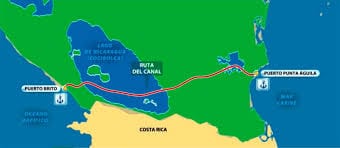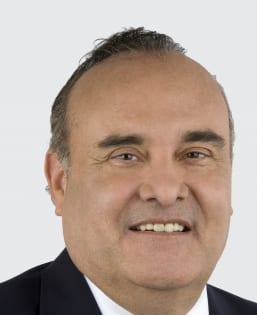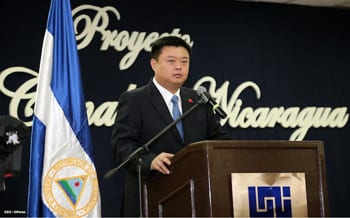Chinese Entrepreneur to Build Nicaragua Canal Loses Much of His Assets
Likewise, leading Nicaraguan environmentalist Jaime Incer Barquero says: investors are not so dumb as to invest in a canal without preliminary studies

HAVANA TIMES — Wang Jing, owner of the Chinese consortium that is to build and operate the Nicaragua canal, has suffered considerable financial losses, Ivan Olivares reported today on the website Confidencial.com.ni.
The financial fiasco facing the Chinese entrepreneur, who recently saw a US $ 9.1 billion drop in his personal fortune after the shares of the telecommunications company Xinwei lost much of their value, casts doubts on the company’s ability to secure the US $50 billion in investments required to build the canal.
As the financial storm clouds looming over the Chinese magnate gradually clear, environmental exports in Nicaragua continue to express resentment over being denied full access to the Environmental and Social Impact Study (ESIS) presented by Environmental Resources Management (ERM).
Even the renown Nicaraguan environmentalist Jaime Incer Barquero, the president’s advisor for environmental matters, is skeptical: after reading the executive summary of ERM’s study, he does not believe any investor will be willing to spend money on the interoceanic canal. Incer, who is also the former Minister for the Environment, does not believe a project as immense as the canal that Wang Jing was authorized to build can be undertaken before long and complete studies have been conducted.
“A project of this nature requires many years of study, complemented by exhaustive and concrete analyses, as well as continuous monitoring of natural processes such as sedimentation, pollution and deforestation, in order to plan ways to neutralize environmental damage,” he said during an interview for the television program Esta Semana (“This Week”), aired on Nicaragua’s channel 12.
In addition to studying the canal’s environmental impact in depth, the project’s technical, commercial, financial and social viability must also be assessed beforehand, giving the public real and complete access to information about this process, Incer Barquero pointed out.
In the meantime, opposition to the canal owing to the expected socio-economic and environmental damages have led to a nationwide protest.
The National Council for the Defense of Land, Water and Sovereignty is organizing its 52nd rally to protest the canal, to be held in Managua on October 27, Confidencial reported.
“We expect this protest to be much greater than all previous. We hope protesters will be allowed to express their views peacefully and in a civil manner, without suffering repression,” said Monica Lopez, an environmental attorney at the Popol Nah Foundation in Managua.
The Canal and Damage to Nicaragua’s Biological Corridor
Referring to the scant information obtained from the summary of the environmental impact report, Jaime Incer Barquero points out that the isolated studies conducted “cannot be applied to the entire system in general, as in the case of a lake, a jungle or a coastal area. The isolated nature of the samples means that the findings made at that moment and particular place are not necessarily those we find throughout the ecosystem.”

“What’s interesting is how they acknowledge that there’ll be unavoidable damage, listing a number of adverse effects, without saying a word about how they intend to mitigate these, if they can be mitigated, or how they are going to avoid them, if they can be avoided at all,” he explained.
According to the expert, one of the most significant repercussions the company acknowledges is the loss of the primary and secondary tropical rainforest along the stretch of the canal, “something we had warned about many times. In addition, the canal will break up the biological corridor there, and that prevents the flow of flora and fauna from one part of the ecosystem to the other. While the corridor integrates ecosystems, the canal breaks them apart,” he concluded.
The damage list goes on: the destruction of the impressive biodiversity still preserved at Punta Gorda River, the loss of animal breeding grounds and food, disruption of migratory movements by turtle species at risk of extinction and the introduction of invasive species into the Punta Gorda ecosystem.
The canal will also take larger volumes of sediments to the Pacific Ocean, Caribbean Sea and Lake of Nicaragua, divide the country in two areas (north and south of the canal) and make travel more complicated, displace thousands of people physically and economically (including, most significantly, the last Rama settlement in the Atlantic coast region).
Referring to the need to extract some 715 million cubic meters of sediment from the lake bottom, Incer explains that “regardless of how it is extracted, as these sediments dissolve, and the agro-chemical substances they could contain do so as well, as these are brought up to the surface and suffer the effects of the winds, which tend to be strong over the Lake of Nicaragua, the waters will be stirred up and the currents will distribute these damaging substances across the lake.”
“The loss of water quality after these sediments are stirred up and the loss of wildlife will affect human beings as consumers of water and those animal species. We will also lose the possibility of using this water for irrigation, because you can’t use a resource under so much stress for two different things,” the expert sentenced.
What the promoters are conducting is not a consultation
Bearing all this in mind, Victor Campos the Vice-Chair of the Humboldt Center, which conducted an independent environmental study of the project, does not see any means “to ensure a positive balance. On the contrary, many of the findings in this company report seem to contradict the version of events that government spokespeople have handled with respect to the canal.”

“It is clear that the claim the Lake of Nicaragua (Cocibolca) won’t suffer any significant damage is untrue. ERM suggests the canal will have an irreversible impact on certain things, and that there’s very little chance we will be able to mitigate these effects,” Campos affirms.
In his estimation, “in order to draw an accurate balance, we need to complete all studies. The fact they’ve recommended further studies reveals that we didn’t yet have a precise assessment of the environmental damage we can expect.”
This also reveals that, “from the legal standpoint, this is not a public consultation, for, according to our environmental assessment codes, this information should have been divulged by the media, who had access to the official documents. To date, we haven’t seen a single document from Marena (the Ministry of the Environment) ,the information was not divulged. This is not a consultation,” Monica Lopez charged.
In the long run, secrecy and the withholding of available information undermines the project, for “investors are not dumb enough to invest such large sums of money in a project for which not enough information has been gathered to ensure success,” says Jaime Incer.
“It would be very risky for companies to invest in this project, knowing that the needed ecological studies have not been conducted and social demands have not been met, or that potential financial limitations have not been taken into consideration. No one knows where this adventure will lead them,” Incer Barquero added.
The environmentalist acknowledged that, a year ago, he had the hope Daniel Ortega would reconsider his support for the canal project after seeing the environmental damage that it would cause. Today, he no longer feels hopeful.
“I’m no longer optimistic, because I see that [under Ortega’s administration the forests of Bosawas, the pine forests of Nuevo Segovia and the biosphere reserves are being damaged, while lakes are polluted. The government even authorized the felling of an area of forest near Ciudad Dario for the growing of tobacco. This will pollute the water sources that the locals drink from, and I see no efforts to recover those ecosystems,” he commented.
Wang Jing’s Downfall
The monumental debacle faced by Wang Jing, who saw more than 85 % of his personal fortune vanish into thin air, muddies the waters surrounding the canal project even more. Though he never claimed he would finance the project with his own money, it is reasonable to assume an investor will think twice before giving millions to someone who was unable to adequately manage his own assets.

Economist and finances professor Eduardo Montiel points to a fact that could place obstacles in the way of securing the US $50 billion needed for the project: in much the same way the Chinese entrepreneur lost much of his fortune, so could other magnates on the list of potential investors.
“It deals a blow to all investors in China, but we don’t yet know whether this will make the canal unviable. We don’t know, because we’ve all been kept in the dark,” former Minister of the Treasury Montiel says.
The professor pointed out that “predicting the growth of the stock market is extremely difficult, if not impossible, though, in the specific case of the Chinese stock market (and particularly the Shanghai stock market), you could see it coming, because they’d been growing for two years at spectacular rates without any kind of foundation.”
The growth was so extreme that some company owners decided to warn the public, noting that prices were dramatically inflated.
The Canal Remains Appealing
The fact of the matter is that “China’s financial system is so distorted that investors and people with savings don’t have that many investment options. Sometimes, they invest it apartment complexes and whole cities without even knowing if people are living in them. When the Chinese government prohibited investments in apartments, people flocked to the stock market,” he explained.
This suddenly drew large sums of capital to the stock exchange, in a context in which 80 % of investors are individuals, many of them without secondary schooling, who invested in stocks without even knowing what they were investing in. This gave rise to a stock bubble.
When the bubble finally burst, investors began to sell off their stock, which led to a loss of value of many stocks available on the market, hitting the owners of these companies hard.

Montiel explains that “when you have the kind of money this gentleman allegedly has, it’s hard to know how hard he was actually hit. On the HKND webpage, there is an interview with the vice-president of the company, who acknowledges they were hit hard.”
“This is going to affect all of the investors who saw his stocks plummet, because Wang Jing doesn’t have enough money to finance the canal all by himself,” he adds.
Montiel said “it’s hard to imagine a company without much transparency being able to secure bonds through international markets. There’s no information on the Internet that allows investors to assess Wang Jing’s companies.”
Returning to the question of whether the Chinese magnate’s new financial situation makes the canal unviable, Montiel replies that “it will at least make it more difficult to find investors. It won’t be impossible, least of all if many of them have ties to the Chinese government and army.”
Though we still don’t know who the business partners set to invest in the project are, Montiel adds that “the right to operate an interoceanic canal through Nicaragua for 50 years will help sell the idea to a third party,” concludes the article in Confidencial.
